The Best Florida Shade Trees (With Pictures) – Identification Guide
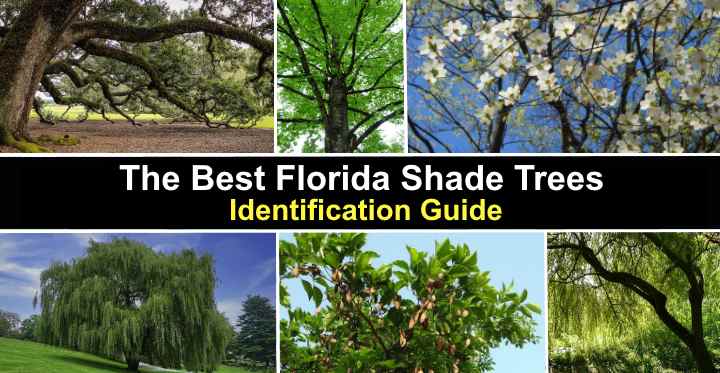
The perfect shade tree can enhance the beauty of your Florida garden landscape. Some of the best shade trees that thrive in Florida are the weeping willow, Shumard oak, river birch, American sycamore, and red maple. These medium to tall trees add to your yard’s aesthetics and help keep your property cool during hot, humid summers.
Choosing the right shade tree for a Florida landscape can be challenging. Florida’s hot and humid climate can make it tricky to find the right trees to thrive in subtropical and tropical conditions. However, the right tree can provide much-needed shade, reduce energy costs, and add visual appeal to your property.
This article explores the best shade trees for Florida. In addition, you will learn about vital factors such as growth rate, drought tolerance, and overall maintenance requirements.
Whether you’re looking for a medium-sized shade tree for your backyard or a fast-growing shade tree for a front yard, you will find what you’re looking for here.
What Types of Shade Trees Grow in Florida?
Medium to large-sized trees with spreading canopies are valued for shade in a Florida landscape. Many homeowners choose fast-growing trees with wide crowns and dense foliage when planning a landscape. Wide varieties of deciduous and evergreen trees suit most of Florida’s growing zones, including in the tropical South Florida climate.
Some small shade trees are excellent additions to gardens in the southeastern United States. For example, small flowering dogwoods, American hornbeam trees, and magnolias provide plenty of shade in compact Florida gardens. In addition to shade, these small trees have stunning flowers, providing color, fragrance, and beauty.
When choosing the best Florida shade trees, it’s vital to consider the climate, growing zone, soil condition, and proximity to the coast. For example, shade trees for central and northern Florida should be suitable for USDA zone 9. However, shade trees for South Florida must be hardy in zone 10.
The Fastest-Growing Florida Shade Trees
The fastest-growing Florida shade trees are the weeping willow, American sycamore, and white poplar. The rapid growth of these ornamental trees means they grow around five feet (1.5 m) annually. Additionally, popular southern shade trees like the tulip tree, Shumard oak, and autumn blaze maple have an average annual growth of three to five feet (0.9 – 1.5 m).
What Are the Types of Native Shade Trees For Florida
Many evergreen and deciduous species of shade trees are native to Florida. For example, the Florida elm and American hop hornbeam are two native trees with appealing rounded crowns and eye-catching colorful fall foliage. Also, the gumbo-limbo and southern magnolia are attractive native shade trees that retain foliage throughout the year.
Florida Shade Trees (With Pictures)
Florida is known for its year-long sunshine and high humidity. Therefore, shade trees are vital in a southern landscape. Whether you’re looking for a fast-growing tree to provide shade in your garden or some greenery to take the edge off the heat, plenty of great options are available.
Here are some of the best Florida shade trees.
Florida Elm (Ulmus americana)
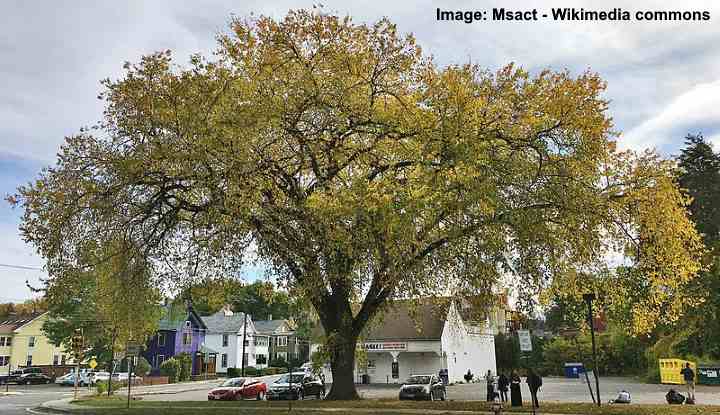
The American elm is a fast growing shade tree for large Florida landscapes that is tolerant of many conditions
The Florida elm is a native tree that thrives in North and Central Florida. This beautiful tree is an excellent shade tree thanks to its upright, spreading habit, vase-shaped crown, and dark-green, leathery leaves. This deciduous tree grows 60 to 80 ft. (18 – 24 m) tall.
Also called the American elm, the Florida elm is a popular lawn and street tree. Its large flat-topped canopy helps keep yards cooler on hot summer days. In addition, the foliage turns an attractive buttery yellow in the fall before the leaves drop.
Due to the prevalence of Dutch elm disease, it’s best to look for resistant cultivars. Some disease-resistant elm varieties include ‘Jefferson,’ ‘New Harmony,’ ‘Princeton,’ and ‘Valley Forge.’
Suitable for USDA zones 2 through 9.
American Hop Hornbeam (Ostrya virginiana)
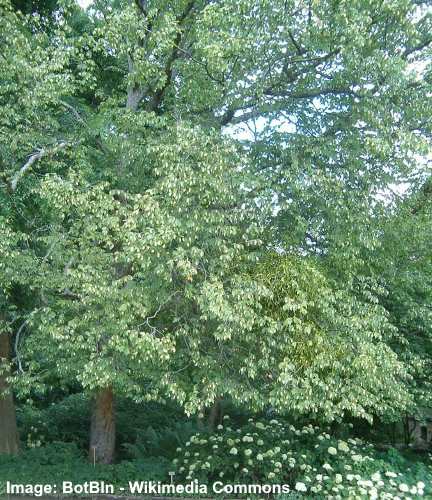
The American hop hornbeam is a decorative Florida shade tree that is relatively small
The American hop hornbeam is a small shade tree for Florida’s hot and humid climate. This attractive tree has an oval to rounded crown, lance-shaped green leaves, and characteristic hop-like papery fruits. This Florida shade tree’s other features are its reddish-brown exfoliating bark, fuzzy catkins, and attractive yellow colors in the fall.
The American hop hornbeam is ideal for compact Florida gardens as a small shade tree. The ornamental tree grows 20 to 40 ft. (6 – 12 m) tall and 30 ft. (9 m) wide.
In addition to its landscaping appeal, its attractive bark that peels in thin strips gives the tree ornamental value in winter. You can plant it as a small shade tree for a patio, specimen tree, or to enhance your property’s curb appeal.
Suitable for growing in USDA zones 5 to 9.
Gumbo-Limbo (Bursera simaruba)
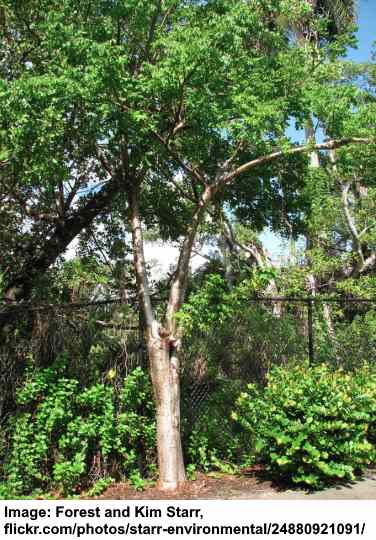
Gumbo-limbo tree is a hardy shade tree suitable for south Florida
Gumbo-limbo is a beautiful and versatile native Florida shade tree that stands out in a southern landscape. This tree is known for its unique red bark that peels in papery strips, pinnately compound leaves, and attractive diamond-shaped red berries. In addition, this semi-evergreen tree has massive branches that spread out, creating a wide crown.
Also called the turpentine tree because of the aroma the crushed leaves emit, the gumbo-limbo tree grows 25 to 40 ft. (7.5 – 12 m) tall.
Several reasons make the gumbo-limbo ideal as a shade tree in Florida. First, it’s resistant to strong winds and hurricanes. Second, it’s suitable for USDA zones 10 and 11. And third, it provides ample shade during hot, humid summer months.
Related reading: Native plants in Florida.
Red Maple (Acer rubrum)
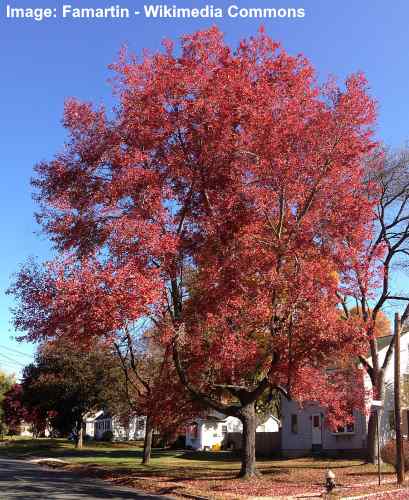
Red maple shade tree has a spectacular autumn foliage and looks great in any Florida landscaped garden
The red maple is a great shade tree for growing in North and Central Florida landscapes. The red maple has plenty of seasonal interest with its vibrant crimson red spring and fall foliage. The shade tree is identified by its smooth gray bark, clusters of small red flowers, and rapid growth.
Red maples thrive in USDA zones 3 to 9, growing 40 to 70 ft. (12 – 21 m) tall and up to 50 ft. (15 m) wide. Thriving in full sun, the maple tree is ideal as a lawn or specimen tree. And its large oval crown provides ample afternoon shade to keep your home and yard cool during the hot Florida summers.
Golden Trumpet Tree (Handroanthus chrysanthus)
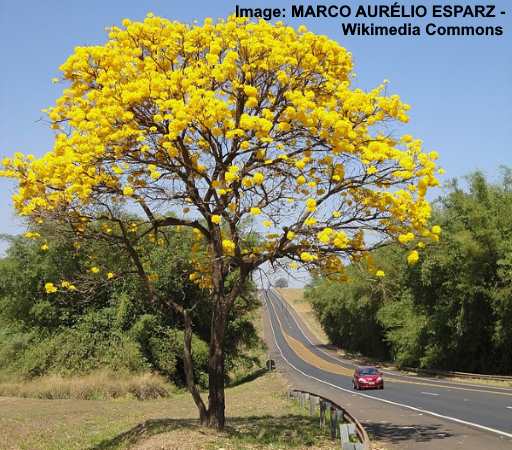
The golden trumpet is a beautiful small shade tree with yellow flowers for central and south Florida
The golden trumpet tree is a striking and attractive shade tree famed for its dazzling floral displays in spring. With its vibrant yellow trumpet-shaped flowers, this small shade tree thrives in Central and South Florida. Apart from its showy clusters of yellow flowers, this southern beauty has gray, deeply furrowed bark and long pod-like fruits.
The golden trumpet tree grows 15 to 25 ft. (5 – 8 m) tall, and its shade canopy spreads 35 ft. (11 m) wide. Drought tolerant once established, the tree requires little maintenance in a compact backyard. It is ideally suited for planting in full sun in USDA zones 10 and 11.
Tulip Tree (Liriodendron tulipifera)
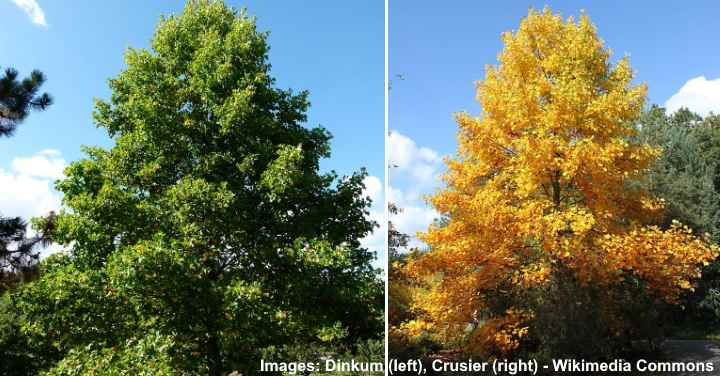
Tulip poplar trees – summer and autumn foliage
The Tulip Tree is a spectacular fast-growing flowering tree in Florida that provides plenty of shade. Attractive features of this flowering shade tree are its unique, tulip-shaped yellow flowers, bright green lobed leaves, and spectacular fall colors. The yellow flowers measure 3” (7.5 cm) across, and the four-lobed leaves are 8” (20 cm).
The tulip tree is a great choice for adding shade and beauty to Central and North Florida yards. The tree’s rapid growth rate averages 3 to 5 ft. (0.9 – 1.5 m) annually. Also called the tulip poplar, this native Florida shade tree grows 60 to 80 ft. (18 – 24 m) tall in full sun.
Southern Magnolia (Magnolia grandiflora)
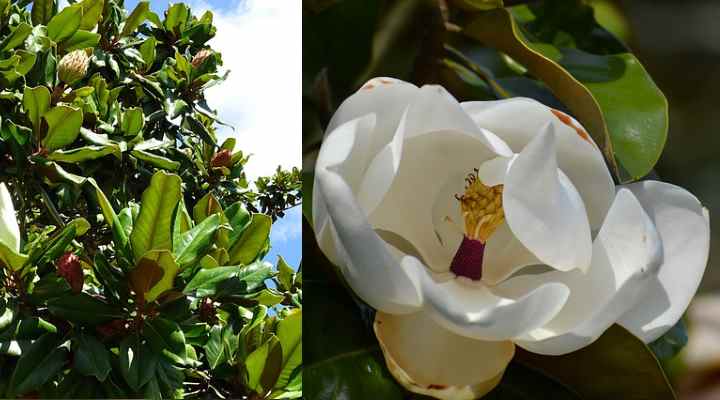
Southern magnolia is an evergreen white flowering large tree that is suitable as a shade tree for most parts of Florida
The southern magnolia tree is a beautiful, evergreen shade tree that thrives throughout the Sunshine State. Outstanding features of this commanding tree are its glossy green leaves and highly fragrant white blossoms. The cup-shaped flowers measure 8” (20 cm) across and open in the morning, creating a stunning display of flowers.
The southern magnolia is a shade tree for Florida gardens that thrives in USDA zones 7 to 10. The ornamental shade tree grows well from the Panhandle in the north to the southern tip of Florida. The fast-growing tree increases by 2 ft. (0.6 m) annually, reaching a mature height of around 80 ft. (24 m).
Perfect for providing shade and privacy in Florida yards, the native southern magnolia stays green all year round. It’s tolerant of sandy to clay soils that are well-drained and moist.
Related reading: How to care for magnolia trees.
Southern Live Oak (Quercus virginiana)
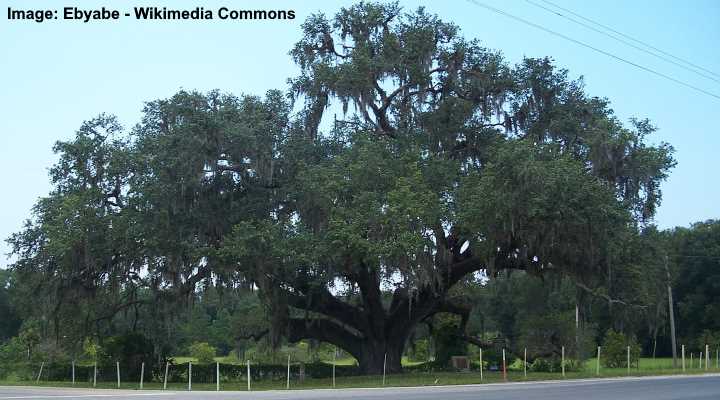
The evergreen live oak tree tolerates many conditions, making it a great Florida shade tree for large areas
The southern live oak is a magnificent evergreen shade tree native to the southeastern United States. This oak species is known for its majestic beauty. It features a wide-spreading crown, dark green glossy leaves, and long horizontal branches covered in Spanish moss. Additionally, the oak tolerates wind, drought, salt, sunshine, and heat.
The southern live oak thrives in full sun in USDA zones 8 to 11. The evergreen oak grows 40 to 80 ft. (12 – 24 m) tall and up to 100 ft. (30 m) wide. This oak is perfect for adding natural shade to any large outdoor space.
Related reading: Types of Florida oak trees.
Shumard Oak Tree (Quercus shumardii)
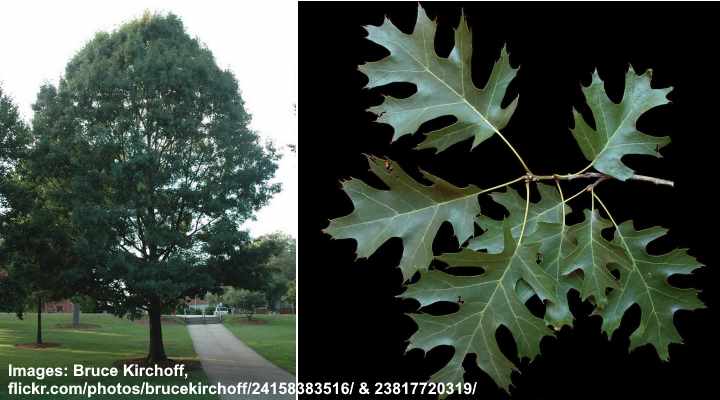
Shumard oak tree has an attractive pyramidal crown and is native Florida shade tree
The Shumard oak is a native Florida shade tree that thrives in most regions of the Sunshine State. This species of red oak tree has leaves with seven to nine deep lobes and pointed ends. Other identifying features of the deciduous tree are its brown, rounded acorns, dark gray bark with rough furrows, and eye-catching red to yellow-copper fall colors.
The Shumard oak grows 40 to 60 ft. (12 – 18 m) tall in full sun. It is suitable as a deciduous shade tree in USDA zones 5 to 9.
Related reading: Types of oak trees.
Flowering Dogwood (Cornus florida)
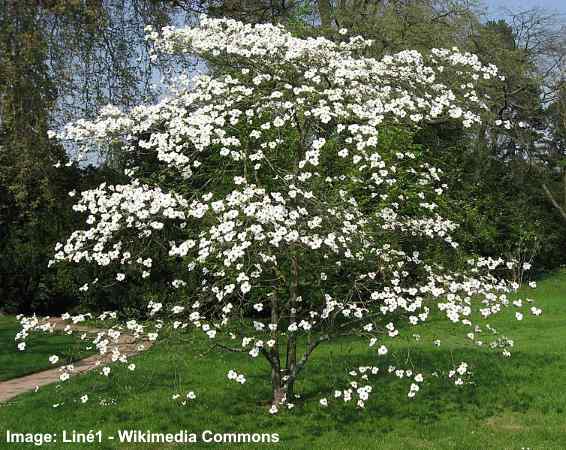
The fast growing dogwood tree is relatively small and has attractive white flowers
The flowering dogwood is a stunning tree with impressive, showy white blooms in spring. This small flowering shade tree has a rounded canopy, star-like flowers, and bright red berries in summer. In addition, the tree has layered branches and bark that looks like alligator skin, providing visual appeal in winter.
Suitable for growing in all Florida regions north of Lake Okeechobee, the native flowering dogwood grows 15 to 23 ft. (4.5 – 9 m) tall and wide. In addition, its leaves turn bright red or purple in the fall. Its compact size and beauty add curb appeal to a front yard.
Florida Maple (Acer saccharum subsp. floridanum)
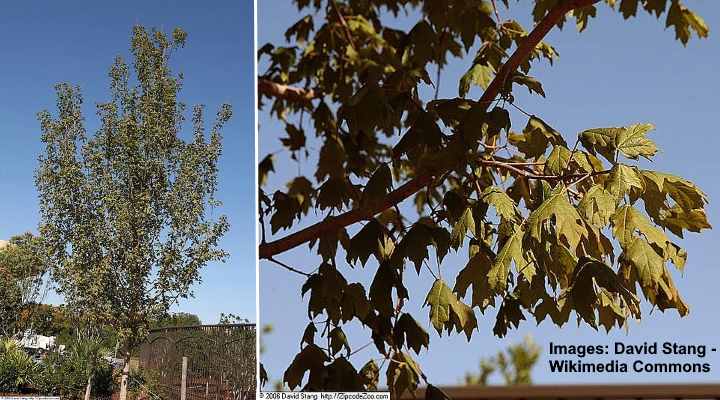
Florida maple is a native Florida shade tree suitable for USDA zones 6 through 9
The Florida maple is a beautiful ornamental or shade tree native to Florida. Identifying features of this Florida shade tree are its spreading canopy of lush green leaves that turn a vibrant yellow or orange in the fall, two-winged samaras, lobed star-shaped leaves, and light gray, smooth bark.
The Florida maple thrives in the Panhandle and Gulf Coast areas of Central Florida. The shade tree grows 20 to 60 ft. (6 – 18 m) and up to 40 ft. (12 m) wide. The Florida maple tree’s dense canopy adds natural beauty and cooling shade to your outdoor space.
Fast-Growing Florida Shade Trees (With Pictures)
The weeping willow and American sycamore are two of the fastest-growing shade trees in Florida. However, several other heat-tolerant trees have rapid growth and will quickly help shade a southern backyard.
American Sycamore (Platanus occidentalis)
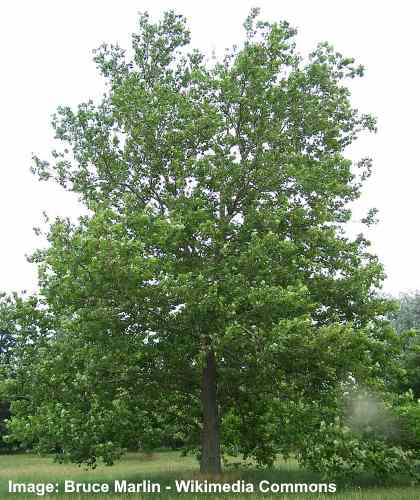
The large American sycamore tree grows fast and is often found along streams, rivers and wetland areas
The American sycamore tree is one of the fastest-growing shade trees in Florida. It’s a large deciduous tree with large lobed leaves, dark brown, smooth, mottled bark, and round fuzzy seed pods in the fall. This sycamore’s foliage is ovate leaves measuring 9” (23 cm) long with three to five lobes.
Suitable for growing in North and Central Florida, the American sycamore thrives in USDA zones 4 to 9. Apart from its rapid growth, attractive features of this shade tree are its dense, wide canopy, golden yellow fall colors, and tolerance for urban conditions.
The fast-growing American sycamore grows 75 to 100 ft. (22 – 30 m) tall and wide in USDA zones 4 through 9.
Weeping Willow (Salix babylonica)
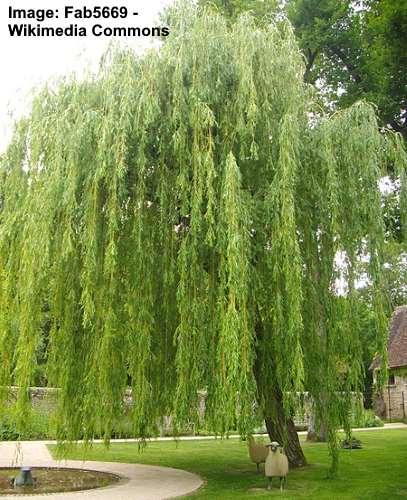
The weeping willow tree grows quickly and can be easily identified by its droopy branches
The weeping willow is a fast-growing ornamental shade tree, growing 3 to 4 ft. (0.9 – 1.2 m) annually. Weeping willows are known for their gracefully drooping branches, narrowly lance-shaped leaves, and long dangling yellow catkins (flower clusters). In early summer, the tree produces brown seed pods containing cotton-like seeds.
The weeping willow is only suitable for growing in Northern Florida, north of Gainesville. The elegant weeping tree grows 30 to 50 ft. (9 – 15 m) tall and wide. The tree thrives along river banks, streams, and ponds. Weeping willow trees are suitable for growing in USDA zones 6 to 8.
River Birch (Betula nigra)
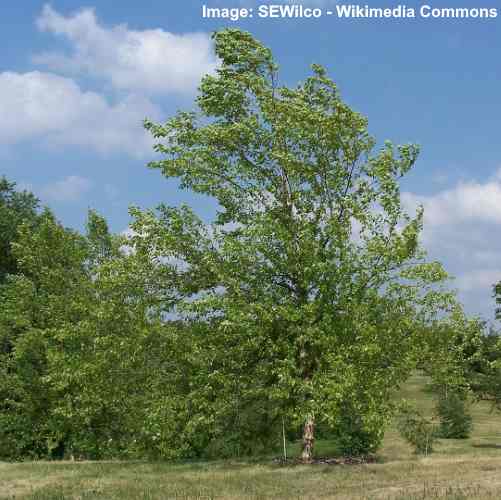
The river birch is an ornamental native Florida shade tree with attractive bark and autumn colors
The river birch tree is a fast-growing shade tree for Florida landscapes that tolerates various soil conditions. This deciduous tree is ideal for Central or North Florida. It is identified by its peeling cinnamon-brown bark, triangular leaves with serrated margins, open, pyramidal canopy, and golden yellow fall colors.
The river birch thrives in full sun or partial shade in USDA zones 4 through 9. The native Florida shade tree grows 30 to 70 ft. (9 – 21 m) tall and up to 60 ft. (18 m) wide.
Thanks to its rapid growth, pyramidal habit, attractive mature bark, and beautiful colors in the fall, the river birch provides stunning visual appeal and natural shade to an outdoor space.
Pongam Tree (Pongamia pinnata)
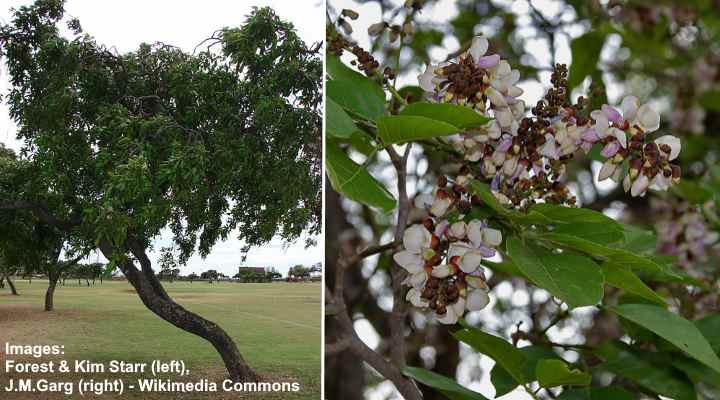
The pongam tree is an ornamental shade tree for south Florida with attractive while-pinkish flowers
The pongam tree is a fast-growing Florida shade tree with evergreen foliage, a wide-spreading crown, and stunning white or lavender pea-like flowers. Suitable for shade in South Florida landscapes, the pongam tree has 3” (7.5 cm) long glossy green leaves, clusters of white spring flowers, and drooping seed pods.
Although not native to North America, the pongam tree performs well in the southern part of the Florida peninsula. The multi-stemmed tree grows 35 to 40 ft. (10 – 12 m) tall and wide. Its spreading crown provides moderate shade in large lawns or near a patio or decking area.
It’s good to note that the pongam tree’s seed pods are poisonous. Therefore, you should avoid planting the tree where children play.
White Poplar (Populus alba)
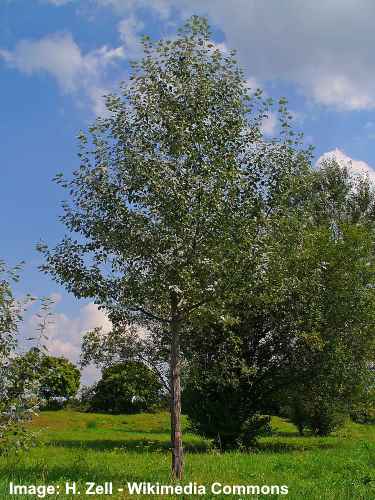
The white poplar tree grows rapidly and is suitable as a shade tree for Florida landscapes
The white poplar tree is a fast-growing deciduous shade tree suitable for most growing regions in the Sunshine State. Identifying features of this poplar tree are its smooth silver-gray bark and dark green, fuzzy leaves with silvery undersides. In addition, the two-toned tree foliage gives the tree a shimmering effect in the wind.
Ideal for USDA zones 4 through 9, the white poplar thrives in full sun and almost any soil type. This poplar tree grows 50 to 100 ft. (15 – 30 m) tall and up to 60 ft. (18 m) wide.
What are the best shade trees for North Florida?
North Florida has several options for shade trees. All deciduous trees suitable for USDA zones 8 and 9 will thrive from the Panhandle to Jacksonville and north of Gainesville. Suitable shade trees for North Florida include the weeping willow, southern live oak, Florida elm, and American Sycamore.
What are the best shade trees for Central Florida?
There are plenty of shade trees suitable for Central Florida. All trees for zone 9 on this list of Florida shade trees thrive in areas north of Lake Okeechobee. Some common types of trees to provide shade in the Florida Peninsula’s central region are the Shumard oak, river birch, white poplar, and the American hop hornbeam.
What are the best shade trees for South Florida?
The choice is limited when finding suitable shade trees that thrive south of Vero Beach and Fort Myers to the Florida Keys. However, there are some stunning heat-tolerant trees for shade. For example, the gumbo-limbo, golden trumpet tree, and magnolia trees are ideal for zones 10 and 11.
You can also check out which dwarf palm trees are suitable for shade in southern Florida.
How to choose a shade tree for a Florida landscape
Choosing the right shade tree for Florida’s environmental conditions can be tricky. Factors to consider include the tree’s mature size, shape, growth rate, and tolerance to Florida’s climate conditions. It is also vital to think about maintenance requirements like pruning and watering. Additionally, some shade trees are messy when their seed pods drop.
In addition, try to avoid shade trees with shallow roots as they may be uprooted in storms or affect the foundations of nearby properties.
Related articles:
